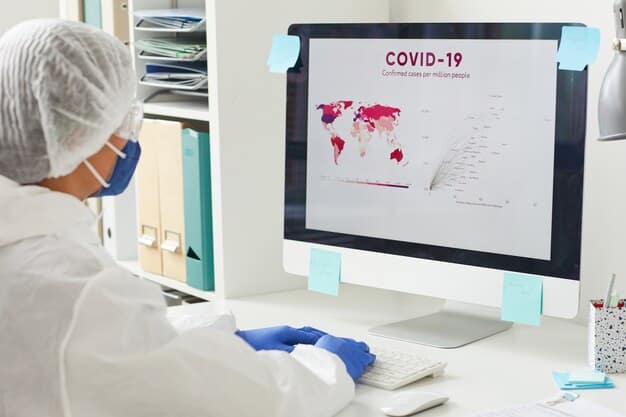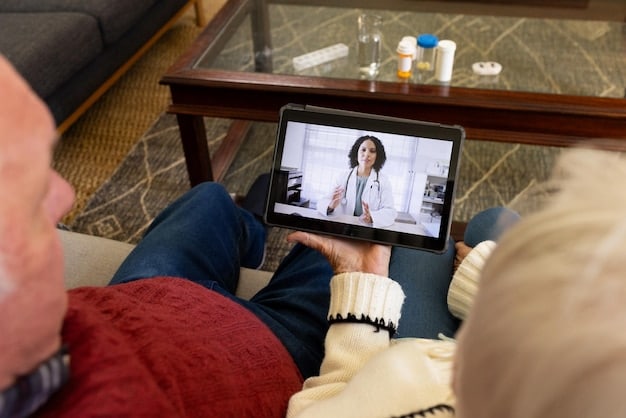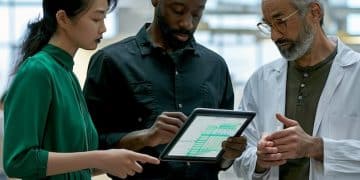Technology in Public Health: Innovations for Disease Prevention

Technology plays a crucial role in public health by providing innovative solutions for disease prevention through advanced data analysis, telehealth, mobile health applications, and improved communication strategies, ultimately enhancing public health outcomes.
The integration of technology into public health has revolutionized the field, offering unprecedented opportunities for disease prevention and health promotion. Exploring the role of technology in public health: exploring innovative solutions for disease prevention is crucial to understand how these advancements can improve health outcomes for individuals and communities.
The Evolution of Technology in Public Health
Technology has fundamentally changed how public health operates, from data collection and analysis to intervention strategies and communication. This evolution has led to more efficient and effective methods for addressing public health challenges.
Early Technological Adoptions in Public Health
The initial uses of technology in public health focused on data management and communication. Simple databases and basic statistical software allowed for better tracking of disease outbreaks and health trends.
- Data Collection: Early adoption facilitated organized collection of health-related data.
- Communication: Allowed for quicker communication among health professionals.
- Statistical Analysis: Provided tools for analyzing health trends and patterns.
These early adoptions set the stage for more sophisticated technological applications, paving the way for today’s innovative solutions.
The Digital Revolution: A Paradigm Shift
The digital revolution brought about a paradigm shift in public health, with the advent of electronic health records (EHRs), mobile health (mHealth), and big data analytics. These technologies enable real-time monitoring and personalized interventions.

Advancements like telemedicine have also expanded access to healthcare services, particularly in rural and underserved areas.
The evolution of technology in public health has transformed practices, enhancing capacity to address complex health issues effectively.
Big Data and Predictive Analytics
Big data and predictive analytics are powerful tools in modern public health. By analyzing vast datasets, public health professionals can identify patterns, predict outbreaks, and tailor interventions more effectively.
Sources of Big Data in Public Health
Public health data comes from various sources, including electronic health records, social media, wearable devices, and environmental monitoring systems. Each source provides unique insights into health behaviors and environmental risks.
- Electronic Health Records (EHRs): Contain comprehensive patient data for analysis.
- Social Media: Offers real-time monitoring of public sentiment and health concerns.
- Wearable Devices: Provide individual-level data on activity, sleep, and vital signs.
Combining these data sources yields a comprehensive understanding of health dynamics, which can be used to drive targeted interventions.
Applications of Predictive Analytics
Predictive analytics can forecast disease outbreaks, identify at-risk populations, and evaluate the effectiveness of public health programs. This capability allows for proactive measures rather than reactive responses.
The use of big data and predictive analytics in public health enables evidence-based decision-making and resource allocation, improving overall health outcomes.
Telehealth and Remote Monitoring
Telehealth and remote monitoring technologies have significantly expanded access to healthcare services, particularly for individuals in rural areas or those with mobility issues. These technologies allow remote consultations, monitoring of chronic conditions, and delivery of specialized care.

Benefits of Telehealth
Telehealth offers several benefits, including increased access to care, reduced healthcare costs, and improved patient outcomes. It eliminates geographical barriers and allows for more frequent monitoring of patients with chronic conditions.
- Increased Access: Provides healthcare to remote or underserved populations.
- Reduced Costs: Lowers the expenses associated with travel and facility use.
- Improved Outcomes: Facilitates timely intervention and management of chronic diseases.
Telehealth has proven to be an effective tool for managing chronic conditions such as diabetes, heart disease, and mental health disorders, enabling continuous care and support.
Remote Monitoring Devices
Remote monitoring devices, such as wearable sensors and home monitoring systems, collect real-time data on vital signs, activity levels, and medication adherence. This data is transmitted to healthcare providers, who can monitor patients remotely and intervene as needed.
These technologies enhance patient engagement and empower individuals to take control of their health, leading to better health outcomes and reduced healthcare costs.
Telehealth and remote monitoring are invaluable in improving healthcare access and outcomes, particularly for underserved populations.
Mobile Health (mHealth) Applications
Mobile health (mHealth) involves the use of mobile devices and applications to support health-related activities. These applications range from fitness trackers and diet planners to medication reminders and mental health support tools.
The Role of mHealth in Health Promotion
mHealth applications play a vital role in promoting healthy behaviors and preventing chronic diseases. By providing personalized feedback, motivational messages, and interactive tools, these applications encourage individuals to adopt healthier lifestyles.
These applications can also be used for disease management, allowing patients to track their symptoms, monitor their medications, and communicate with their healthcare providers.
Challenges and Considerations
Despite the potential benefits of mHealth, there are several challenges to consider, including data privacy, security, and the digital divide. It is essential to ensure that mHealth applications are secure, private, and accessible to all populations.
mHealth offers innovative ways to promote health and prevent disease, with careful consideration of the associated challenges.
Disease Surveillance and Tracking
Technology has dramatically improved disease surveillance and tracking capabilities. Real-time data collection, advanced analytics, and rapid communication systems enable public health officials to detect and respond to outbreaks more quickly and effectively.
Real-Time Data Collection
Real-time data collection involves the use of electronic reporting systems, mobile applications, and social media to gather information about disease incidence, symptoms, and risk factors. This data is used to monitor disease trends and identify potential outbreaks.
- Electronic Reporting Systems: Facilitate the rapid reporting of notifiable diseases.
- Mobile Applications: Enable individuals to report symptoms and health behaviors.
- Social Media: Provides insights into public sentiment and potential outbreaks.
Real-time data collection enables public health professionals to detect outbreaks early, facilitating timely interventions and preventing widespread transmission.
Advanced Analytics and Visualization
Advanced analytics and visualization tools help public health officials identify patterns, trends, and hotspots of disease transmission. These tools enable a deeper understanding of disease dynamics and inform targeted interventions.
The combination of real-time data collection and advanced analytics enhances disease surveillance and tracking efforts, ultimately protecting public health.
Ethical Considerations and Data Privacy
As technology plays an increasing role in public health, ethical considerations and data privacy become paramount. Protecting individual privacy while leveraging data for public health benefits requires careful planning and robust safeguards.
Balancing Public Health and Individual Privacy
Balancing the need for public health data with individual privacy rights is a complex challenge. It is essential to implement policies and procedures that protect personal information while allowing for the use of data for legitimate public health purposes.
These measures include de-identification of data, secure storage and transmission protocols, and transparency about how data is collected, used, and shared.
Ensuring Equity and Access
Ensuring equitable access to technology and addressing the digital divide are critical for promoting health equity. Public health interventions must be designed to reach all populations, regardless of their socioeconomic status, education level, or geographical location.
By addressing these ethical considerations and ensuring data privacy and security, technology can be used to promote health equity and improve public health outcomes for all.
| Key Point | Brief Description |
|---|---|
| 📊 Data Analytics | Analyzing big data to predict outbreaks and improve health outcomes. |
| 📱 mHealth Apps | Mobile apps supporting health activities like fitness tracking and medication reminders. |
| ⚕️ Telehealth | Remote healthcare services that expand access to medical consultations and monitoring. |
| 📡 Disease Tracking | Using technology to monitor and track diseases in real-time for quick response to outbreaks. |
Frequently Asked Questions
▼
Technology enhances public health by improving data collection, enabling remote monitoring, facilitating communication, and promoting healthier behaviors through various mobile applications and digital interventions.
▼
mHealth refers to the use of mobile devices and applications to support health-related activities. In public health, mHealth is used for tracking, promoting healthy habits, and managing chronic conditions.
▼
Big data in public health involves analyzing vast datasets from various sources. It can predict disease outbreaks, identify patterns, and tailor interventions for improved outcomes.
▼
Ethical considerations include data privacy, potential biases in algorithms, and digital equity. Transparency and robust safeguards are essential to protect individual rights and promote fair outcomes.
▼
Telehealth expands healthcare access by eliminating geographical barriers, reducing travel costs, and enabling remote consultations. It proves useful for managing chronic diseases and reaching underserved populations.
Conclusion
In conclusion, technology plays an increasingly vital role in public health by providing innovative solutions for disease prevention, health promotion, and healthcare access. By leveraging data analytics, telehealth, mHealth applications, and other digital interventions, public health professionals can improve health outcomes for individuals and communities. Despite the challenges associated with data privacy and equity, the integration of technology into public health holds immense potential for creating a healthier and more equitable future for all.





